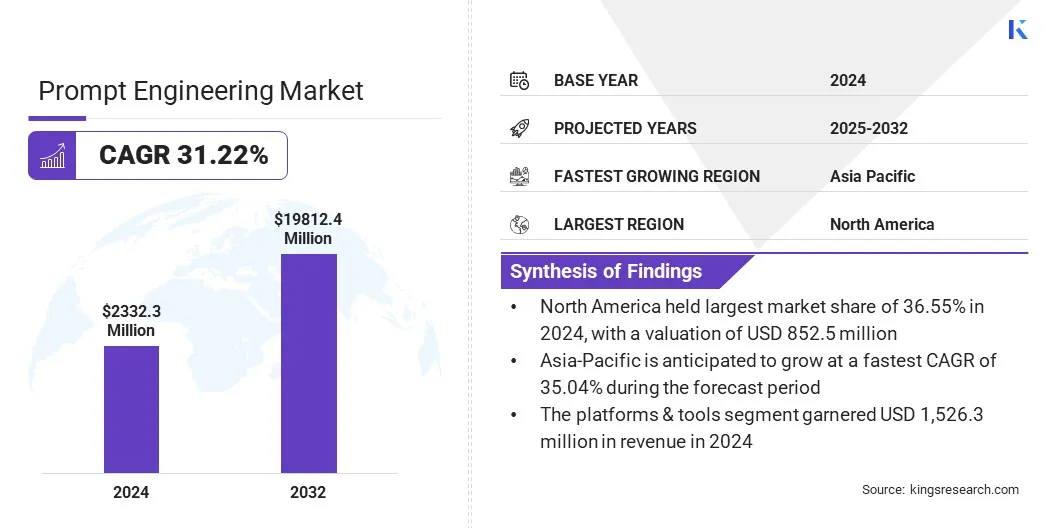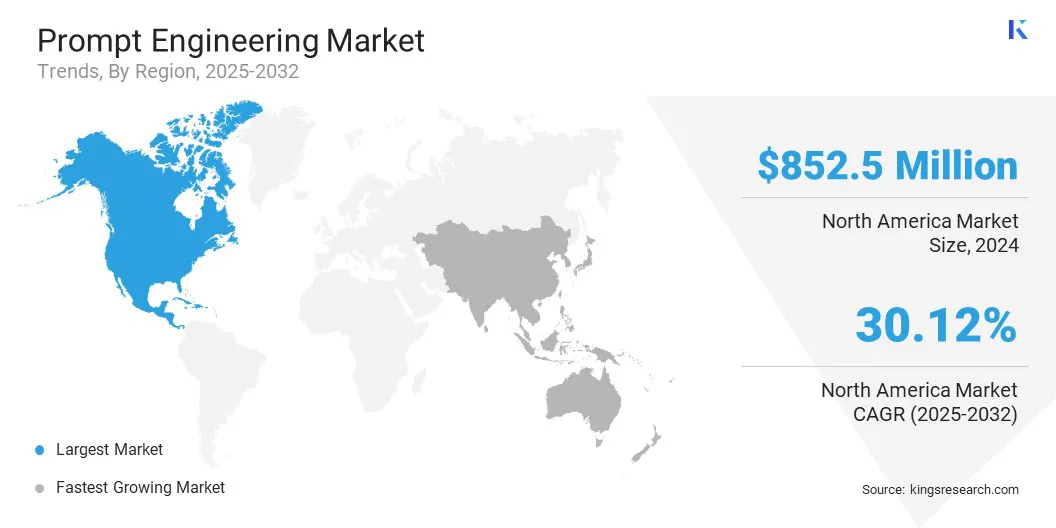buyNow
Prompt Engineering Market
Prompt Engineering Market Size, Share, Growth & Industry Analysis, By Component (Platforms & Tools, Services), By Technique (n-Shot Prompting, Generated Knowledge Prompting, Chain-of-Thought Prompting, Others), By Application (Content Generation, Conversational AI, Recommendation Systems, Software Development), By End-use Industry, and Regional Analysis, 2025-2032
pages: 210 | baseYear: 2024 | release: July 2025 | author: Versha V.
Market Definition
Prompt engineering is the process of crafting and optimizing inputs to guide the behavior and output of artificial intelligence models, especially large language models. It enables more accurate, context-aware, and task-specific responses without altering the underlying model architecture.
Prompt engineering is essential for content generation, customer support, coding assistance, and decision automation across industries. The prompt engineering also supports toolkits, platforms, and services that streamline prompt design, improve output quality, and enable the scalable integration of generative AI into enterprise workflows.
The global prompt engineering market size was valued at USD 2,332.3 million in 2024 and is projected to grow from USD 2,958.1 million in 2025 to USD 19,812.4 million by 2032, exhibiting a CAGR of 31.22% during the forecast period.
This growth is attributed to the rising adoption of prompt engineering across software development, customer service, education, and enterprise automation. The increasing demand for accurate and context-aware responses from generative artificial intelligence models is boosting the use of prompt engineering to enhance task-specific outputs and improve system reliability.
Major companies operating in the prompt engineering market are Microsoft, Amazon Web Services, Inc., Salesforce, Inc., NVIDIA Corporation, OpenAI, Anthropic PBC, Hugging Face, Inc., Nitor Infotech, A3Logics, LeewayHertz., Curved Stone Limited, Promptitude, X.AI LLC, Vocify Inc., and Alibaba Cloud.
Key Highlights
- The prompt engineering industry size was valued at USD 2,332.3 million in 2024.
- The market is projected to grow at a CAGR of 31.22% from 2025 to 2032.
- North America held a market share of 36.55% in 2024, with a valuation of USD 852.5 million.
- The platforms & tools segment garnered USD 1,526.3 million in revenue in 2024.
- The generated knowledge prompting segment is expected to reach USD 7,156.3 million by 2032.
- The software development segment is anticipated to register the fastest CAGR of 36.02% over the forecast period.
- The IT & telecommunications segment garnered USD 748.7 million in revenue in 2024.
- The market in Asia Pacific is anticipated to grow at a CAGR of 35.04% during the forecast period.

Prompt Engineering Market Report Scope
|
Segmentation |
Details |
|
By Component |
Platforms & Tools, and Services |
|
By Technique |
n-Shot Prompting, Generated Knowledge Prompting, Chain-of-Thought Prompting, and Others |
|
By Application |
Content Generation, Conversational AI, Recommendation Systems, Software Development, and Others |
|
By End-use Industry |
IT & Telecommunications, BFSI, Media & Entertainment, Healthcare & Pharmaceuticals, Retail & E-commerce, and Others |
|
By Region |
North America: U.S., Canada, Mexico |
|
Europe: France, UK, Spain, Germany, Italy, Russia, Rest of Europe | |
|
Asia-Pacific: China, Japan, India, Australia, ASEAN, South Korea, Rest of Asia-Pacific | |
|
Middle East & Africa: Turkey, U.A.E., Saudi Arabia, South Africa, Rest of Middle East & Africa | |
|
South America: Brazil, Argentina, Rest of South America |
Prompt Engineering Market Regional Analysis
Based on region, the global market has been classified into North America, Europe, Asia Pacific, the Middle East & Africa, and South America.
North America accounted for a prompt engineering market share of 36.55% in 2024, valued at USD 852.5 million. This dominance is reinforced by the region’s early integration of generative artificial intelligence (Gen AI), strong presence of leading AI and cloud service providers, and high enterprise demand for scalable automation solutions.
Furthermore, increasing investments in AI research by major technology companies, government-backed digital transformation initiatives, and collaborations between technology firms and academic institutions continue to drive the adoption of prompt engineering across finance, healthcare, and enterprise software.
North America's focus on maintaining leadership in AI innovation and commercial deployment further solidifies its market position. The growing demand for advanced conversational agents, content generation tools, and domain-specific AI applications, along with ongoing advancements in prompt optimization platforms and infrastructure, strengthens region’s prompt engineering expansion.

The prompt engineering industry in Asia Pacific is set to grow at a CAGR of 35.04% over the forecast period. This growth is propelled by accelerating digital transformation initiatives and the rising adoption of Gen AI across key economies in the region.
Government-led AI strategies, along with increased funding for innovation hubs and academic research by governments and private technology firms, are supporting the development of region-specific prompt engineering solutions.
The growing presence of AI start-ups and technology accelerators is fueling the demand for tools and platforms that enhance prompt efficiency and language adaptability across diverse applications.
Moreover, the need for multilingual, culturally relevant, and context-aware AI outputs is boosting the use of prompt engineering in education, retail, and telecommunications. The region’s expanding tech infrastructure and enterprise digitization efforts are reinforcing market momentum, positioning Asia-Pacific as a major contributor to the growth of the global market.
Prompt Engineering Market Overview
The growing emphasis on operational efficiency, reduced model fine-tuning, and scalable deployment of large language models is fueling the market. Additionally, ongoing advancements in AI tooling, prompt optimization platforms, and integration with low-code development environments, along with increasing investments in AI infrastructure by leading technology firms, cloud service providers, and government agencies, are accelerating market development.
- In September 2023, Salesforce introduced Prompt Builder, a low-code tool that allows users to create and deploy trusted AI prompts directly within Salesforce workflows. Designed to enhance productivity and automate tasks, Prompt Builder enables teams to embed Gen AI across customer service, sales, and marketing operations without deep technical expertise.
Market Driver
Widespread Adoption of Gen AI
The growth of the prompt engineering market is driven by the widespread adoption of Gen AI technologies across enterprises aiming to enhance automation, productivity, and user interaction.
Organizations deploying large language models for content creation, customer engagement, coding support, and data summarization increasingly rely on well-crafted prompts to ensure relevant and high-quality outputs. Prompt engineering enables efficient model performance without retraining or offering a scalable and cost-effective approach to AI integration.
This shift is further supported through the rising implementation of AI-powered platforms in finance, healthcare, retail, and education, where accuracy, customization, and contextual relevance are crucial. The need for domain-specific solutions, reliable human-AI collaboration, and the seamless deployment of foundation models continues to push investments in prompt optimization tools and techniques, accelerating the overall market trajectory.
- In March 2025, Talkdesk Inc. introduced Knowledge Creator and Knowledge Scopes, which are AI-driven tools that automatically identify knowledge gaps and generate contextually relevant content for virtual and human agents, streamlining knowledge base management and boosting chatbot & agent accuracy.
Market Challenge
High Dependence on Trial-and-Error Methods
High reliance on trial-and-error methods presents a significant challenge for the growth of the prompt engineering market, particularly for enterprises seeking consistent and scalable AI implementation.
Crafting effective prompts often requires repeated testing, manual adjustments, and contextual fine-tuning, which increases development time and resource consumption.
The lack of standardized guidelines or predictive tools further complicates prompt optimization, leading to inconsistent outputs and inefficiencies across applications such as chatbots, content generation, code generation, and virtual assistants, and industries including information technology, healthcare, media and entertainment, retail and e-commerce, and financial services. These limitations hinder large-scale deployment and reduce the operational reliability of Gen AI systems.
Companies are developing automated prompt-tuning frameworks, reusable prompt libraries, and prompt evaluation metrics to streamline the optimization process. AI platform providers are also introducing integrated development environments and model feedback tools that simplify experimentation and reduce iteration cycles.
Additionally, increased investment in training programs by technology companies and community-driven knowledge sharing is helping build a skilled workforce, which is capable of advancing prompt engineering practices and improving output consistency.
Market Trend
Automated Prompt Generation & PromptOps
Automation of prompt generation and the emergence of PromptOps are transforming the prompt engineering market by enabling scalable, consistent, and efficient interaction with Gen AI systems.
Tools and frameworks that support automated prompt creation, version control, testing, and deployment are replacing manual trial-and-error processes, significantly reducing development time and improving output reliability. These advancements are streamlining AI integration across virtual assistants, content generation, and enterprise automation.
The adoption of PromptOps allows organizations to treat prompts as structured and testable assets within AI pipelines, supporting continuous optimization and performance tracking. Integrated environments now offer feedback loops and monitoring tools that refine prompts based on real-time usage data.
Additionally, automation enhances reproducibility and quality assurance, making large-scale AI deployments more manageable and effective. These developments are laying the foundation for a more mature and industrialized prompt engineering ecosystem, which is characterized by speed, accuracy, and operational scalability.
Market Segmentation
- By Component (Platforms & Tools and Services): The platforms & tools segment earned USD 1,526.3 million in 2024, due to the growing demand for automated prompt design, optimization frameworks, and integrated development environments that streamline Gen AI deployment.
- By Technique (n-Shot Prompting, Generated Knowledge Prompting, Chain-of-Thought Prompting, and Others): The n-shot prompting segment held 40.12% share of the market in 2024, due to its effectiveness in enhancing model accuracy and contextual understanding by providing multiple examples within prompts for improved task-specific performance.
- By Application (Content Generation, Conversational AI, Recommendation Systems, Software Development, and Others): The conversational AI segment is projected to reach USD 6,124.7 million by 2032, owing to the increasing adoption of large language models in customer support, virtual assistants, and enterprise chatbots that require optimized prompts for accurate and real-time human-like interactions.
- By End-use Industry (IT & Telecommunications, BFSI, Media & Entertainment, Healthcare & Pharmaceuticals, Retail & E-commerce, and Others): The healthcare & pharmaceuticals segment is anticipated to grow at a CAGR of 36.02% through the forecast period, due to the increasing use of Gen AI in medical documentation, decision support, and patient interaction requiring precise prompt design.
Competitive Landscape
The prompt engineering industry is characterized by the presence of major technology companies and emerging AI startups competing on innovation, automation capabilities, and domain-specific expertise. Key market participants are focusing on the development of advanced prompt optimization tools, automated tuning frameworks, and scalable deployment platforms to enhance the accuracy, efficiency, and adaptability of Gen AI systems.
Companies are also investing in research and development to create reusable prompt libraries, integrate prompt engineering into low-code environments, and support multilingual and context-sensitive applications across industries.
Furthermore, strategic collaborations with cloud service providers, academic institutions, and enterprise software vendors, along with mergers, acquisitions, and open-source contributions are being utilized to strengthen global market presence, accelerate product innovation, and expand application coverage across healthcare, finance, education, and customer service.
- In November 2023, xAI LLC launched Prompt Integrated Development Environment (PromptIDE), a tool designed for prompt engineering and interpretability research. It features a Python-based editor, software development kit, version control, and analytics like token-level output and attention visualization to streamline prompt creation, testing, and collaboration.
List of Key Companies in Prompt Engineering Market:
- Microsoft
- Amazon Web Services, Inc.
- Salesforce, Inc.
- NVIDIA Corporation
- OpenAI
- Anthropic PBC
- Hugging Face, Inc.
- Nitor Infotech
- A3Logics
- LeewayHertz
- Curved Stone Limited
- Promptitude
- AI LLC
- Vocify Inc.
- Alibaba Cloud
Recent Developments (Launch)
- In January 2024, Vellum launched its new Execute Prompt APIs, allowing developers to programmatically run, manage, and iterate prompts across different large language models. These APIs streamline prompt deployment, enable dynamic input handling, and support real-time experimentation, making it easier to integrate prompt engineering into production-grade applications.
freqAskQues
